What is genetic inheritance? Genetic inheritance is the process in which a child gains genetic traits from its parents.
Every one of us inherits specific characteristics from our parents that we cannot change. We inherit these genetic features through the reproductive process known as fertilization.
Genes determine embryogenesis (the development of a new individual within its egg cell) by directing cell activities.
For example, it determines hair and eye color, skin pigmentation and texture, blood type, etc.
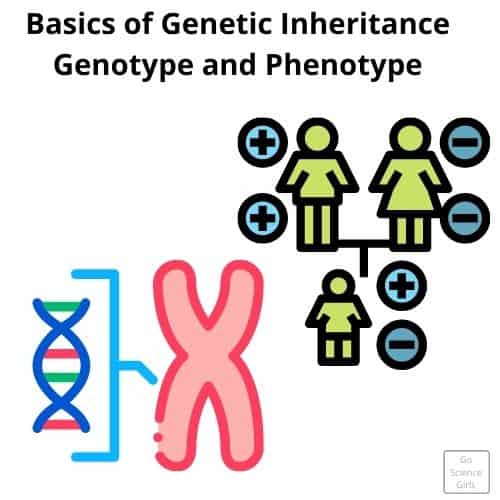
The passed genes contain crucial information that will determine how the offspring will look, its capacity towards certain diseases, and even behavioral traits.
However, not all genetic markers or disorders pass on from one generation to another; some result from multiple genes working in concert.
The following article explains the concept of genetic inheritance through examples and pictures.
If you’re having a tough time understanding genetic inheritance, know that you’re not alone.
There are plenty of people who have been taught the basics of genetics and expect everything to make sense without further knowledge.
Genetics is not the most straightforward science by any means, and you can undoubtedly be confused if you don’t have a solid grasp on the basics.
No worries, because this article will help you understand what genetic inheritance is.
Basics of Genetic Inheritance- Genotype and Phenotype
To understand the exact science of genetic inheritance, we must first appreciate some basic genetic vocabulary and concepts.
We’ll start with the terms genotype and phenotype, discuss their relationship and look at why we choose to study them.
Genotype
A genotype is the genetic constitution of an organism. It may refer to an entire organism or, in principle, a cell or other unit of selection.
Scientists can apply the word genotype to bacteria, plants, animals and cyanobacteria.
The same gene can be present in different forms in similar organisms, these are known as alleles.
A genotype is the combination of alleles present in an organism- regardless of the question if we can see it in the physical appearance of the body.
Phenotype
A phenotype is an observable and/or a measurable characteristic of an organism.
A phenotype results from the interaction between an organism’s genotype and the environment, including culture or situations in which they find themselves.
The phenotype of an organism describes how it expresses its traits. If two contrasting alleles are present in the organism, the characteristic that expresses itself is known as the phenotype.
How Does Genetic Information Pass From One Generation To Another?
Genetic information, including genes and DNA, controls the development, maintenance, and reproduction of organisms.
Understanding heredity for humans and other organisms can help you understand basic biology principles and can help you make decisions regarding your life based on your genes.
But how do they pass from one generation to another?
In the simplest sense, parents pass genetic information from one generation to another through the units of inheritance (genes), which are made of DNA.
Most of the chemical information or DNA is in chromosomes, which are thread-like structures within a cell nucleus. A human cell has 46 chromosomes.
Each chromosome contains thousands of genes. The gene on each chromosome produces a protein that makes it function properly. It regulates almost every aspect of an organism.
Each individual is unique and has different genetic material. The process of sexual reproduction gives the offspring this new genetic material, which allows for the creation of something entirely new.
Organisms repeat this process with slight variations until a group all shares similar characteristics–this is known as ‘evolution.’
Genetic Inheritance Through Sexual and Asexual Reproduction
Organisms reproduce and create new organisms with a similar genotype. The process in which two individuals produce organisms is sexual reproduction, through the union of two gametes.
Asexual reproduction occurs when there is no union of gametes, but still they make a copy of the organism. So, let’s look at the difference between the offspring formed due to sexual and asexual reproduction.
Sexual Reproduction
In humans, sexual reproduction involves combining genetic material through fertilization, which is the fusion of female gamete (egg) and male gamete (sperm).
Gametes are haploid cells, which means they have only one set of 23 chromosomes. Genetic inheritance begins when a sperm cell containing one chromosome from each pair fuses with an egg cell containing one chromosome from each one.
The resulting zygote contains twenty-three chromosomes (one from each pair), including a combination of maternal, paternal, and recombinant DNA.
Therefore, when the two sex cells combine, their two single sets become a new diploid cell, which has 46 chromosomes- 23 pairs of chromosomes.
The transmission of an individual’s genetic information through generations is divided into two primary classes: sex-linked and autosomal.
There are twenty-three chromosomes in the human body, which contain genetic information. The sex-linked chromosome, when combined with the other, decides the sex of the newborn.
The remaining 22 chromosomes control the transmission of genetic information in non-sex-linked genes like eye color, skin color, nose shape, etc.
This process is based on the twenty-two pairs of non-sex-linked chromosomes, which are labelled as autosomes.
Autosomal Inheritance
In human genetics, autosomal inheritance is the independent inheritance of a physical characteristic, not linked to a sex chromosome.
The offspring receives two alleles (a form of a gene), one from either parent, to form a genotype.
However, only one of the two characteristics, received from the mother and the father, can be expressed in the baby. So, depending on the information, we are faced with one of four situations:
Dominant genes
Human beings possess two sets of genes, one inherited from their mother and the other from their father.
A dominant trait is when only one of the two recipes is expressed, be it the mother’s or the father’s, with one dominating over the other. A capital letter represents the dominating genes.
For example: Let’s suppose that the information from a mother is “tall” and from the father is “short“.
An individual cannot be both tall and short. We could say that we have a dominant trait because the individual will need only one-out-of-two chromosomes for producing the result. Since tallness is the dominant gene, the offspring will be tall.
Recessive genes
A recessive trait or character is displayed when the individual gene codes but is not expressed in the offspring’s physical appearance.
They are in recess, which means they are hidden. The other trait in the gene codes dominates over these traits.
These traits can only express themselves when an identical allele is present. They are represented by a small letter.
For example: Let’s suppose the father has black hair, and the mother has red hair.
The offspring gets chromosomes of both black and red hair. However, since red hair is recessive compared to black hair, the baby will express black hair.
The red hair will be hidden in the gene codes. It’ll only express itself if two red-hair alleles are present. Now, observe the diagram below.
Note that the green color of the pod is a dominant trait compared to the yellow color of the pod.
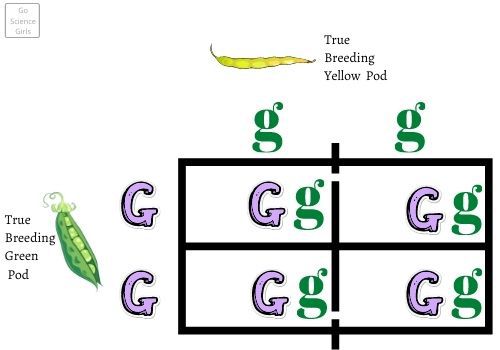
Co-Dominant genes
In biology, a codominant expression of two alleles from one or both parents is referred to as co-dominant inheritance.
Co-dominant inheritance occurs when both alleles are expressed at the same time. It is a relationship between two versions of a gene where individuals receive one version of a gene, called an allele, from each parent. In codominance, neither allele is recessive, and the phenotypes of both alleles are expressed.
For example: The phenotype caused by the ABO blood group system. In this example, both alleles (the B allele and the A allele) are expressed. So if an individual inherits allele A from their mother and allele B from their father, the individual has blood group AB. This is because A and B alleles are codominant, and neither are recessive.
If A or B were to combine with an O allele (a recessive gene), the offspring would have A or B blood type. The O would be hidden in the genotype.

Intermediate Genes
In genetics, an intermediate trait occurs when both recipes are expressed at the same time. So, the resulting character or trait is an intermediate expression of both because neither dominates over the other.
Think about it like a pie. There are two recipes. The first recipe has 1 cup of flour and 1 cup of sugar, while the second recipe has 2 cups of flour and 1/4 cup of sugar.
When we mix both recipes, we get a pie with an intermediate value between the two recipes- 3/2 cups of flour and 5/8 cups of sugar. The same concept applies to genes in biology.
For example: If we cross-bred white flowers with red flowers, the descendants will have pink flowers. The pink flowers result from mixing up both pigments. Like so:
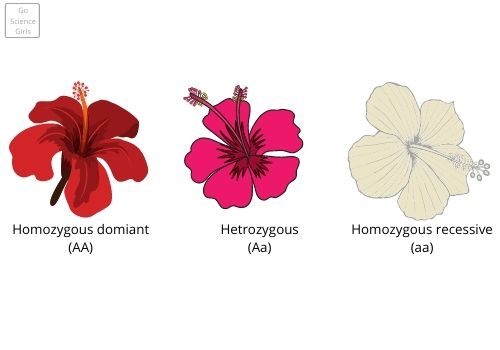
Sex-Linked Inheritance
The sex of offspring, like eye color, is determined by the twenty-third pair. The individuals that procreate choose the genetic makeup of the offspring.
Genetics is a complex process in which mothers and fathers pass on chromosomes to the child. When this happens, the characteristic of gender occurs and can be female (XX) or male (XY).
The X chromosome has a gene essential to female development, while the Y chromosome is present in males only.
Therefore, a female will result if an egg gets fertilized by an X chromosome (XX), while a male will occur if a sperm contributes an X or a Y chromosome during fertilization.
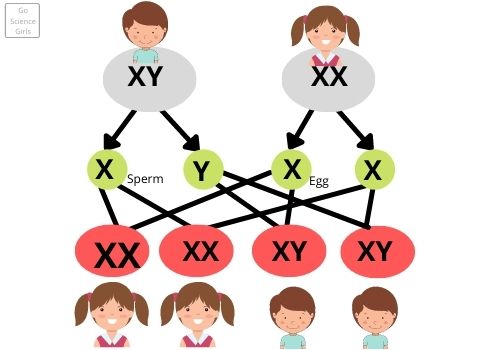
Asexual Reproduction
Asexual reproduction involves one parent. Therefore, there is no fusion of gamete or exchange of chromosomes. So, the offspring is an identical copy of the parent.
It inherits all the characteristics, favourable or unfavourable. Since there is less scope for variation, the survival probability of an asexually reproducing organism is lower than a sexually reproducing one.
This is because sexual reproduction creates a completely unique organism, and leaves a range for variation.
The earth is changing constantly. Carbon dioxide levels are increasing, and as a result, so are heat levels.
If it wants to survive, an organism needs to build up resistance via variation. However, biochemical processes are not always reliable.
So, when an organism reproduces, certain favourable traits pass on- which then accumulate because of the process of evolution.
For example, imagine bacteria living in a pond. The pond is gradually getting warmer because of global warming.
So, imagine that due to a fault in the biochemical aspect of reproduction, the offspring builds up a little heat resistance. Thus, the heat resistance will consistently increase throughout the generations.
Thus, this line of bacteria will survive global warming, whereas other asexually reproducing organisms will die. That’s how important genetics is!
Patterns of Genetic Inheritance of Diseases
Genetic disorders occur when a gene is mutated or damaged. They can be passed along in several ways, each of which is associated with different genetic disorders. Children inherit most genetic diseases in five major ways:
Dominant Genetic Diseases
Dominant genetic disease is when a gene inherited from a parent affects the child’s phenotype, even though they inherited copies of that gene from each parent.
These diseases are also referred to as monogenic disorders, meaning only one gene causes them. If one parent carries the gene for a dominant condition, each child has a 50% chance of inheriting that gene.
Examples of these diseases are Huntington’s disease, Marfan syndrome, Achondroplasia, etc.
Recessive Genetic Diseases
A recessive genetic disease is caused by inheriting the same abnormal gene for the same trait from each parent.
They differ from dominant genetic diseases because two abnormal genes are necessary to develop the disease. Here, suppose both parents have the same recessive disorder.
In that case, there is a 50% chance the offspring will only inherit one mutated allele and become a carrier, a 25% chance that it will be completely healthy with no mutation, and a 25% probability that it will have the disease.
Examples of these diseases are Cystic Fibrosis, Phenylketonuria, Galactosemia, etc.
Sex-Linked Genetic Diseases
Sex-linked genetic diseases are a smaller subset of autosomal recessive diseases that affect males and females differently. This results from gene mutations on the X or Y chromosomes.
When a man has a genetic mutation, the illness-causing chromosome is non-functional from birth, and usually affects him adversely.
A woman’s other functioning chromosome takes over for the non-functioning one leaving her healthy.
Hemophilia is an example of an X-linked disease, whereas color-blindness is an example of a Y-linked disease.
Multifactorial Diseases
Multifactorial inheritance is a phenomenon where the phenotype of an individual depends on multiple genetic loci.
Inheritance patterns are determined by the interaction between at least one genetic locus, making it possible to pass a gene through indirect means and maybe even generations.
Multifactorial traits occur because of many complex interactions and combinations of maternal, environmental, and genetic influences.
The most common congenital disabilities are members of this category, including congenital heart defects and cleft lip.
Another multifactorial condition is spina bifida, a type of open neural tube defect.
Mitochondrial Diseases
Scientists base mitochondrial inheritance on the genes in mitochondrial DNA, which are a part of your mother’s genetic contribution.
These genes are only passed down through the mother, the father can never damage the egg cell.
An example of mitochondrial disease is Leber Hereditary Optic Neuropathy (sudden vision loss.)
Genetic Inheritance in Eyes
Every person has been born with his or her eye color, but how it will develop depends on many factors. To start, let’s look at the two key aspects that contribute to iris pigmentation: eye color genetics and melanin production.
A person’s eye colour depends on how much melanin they store in the iris. However, the genetics of eye colour are complex and include many genes besides the ones for melanin, and also involve interactions with the environment and with the other genes.
The variation in eye color arises from the qualitative and quantitative combination of multiple factors—genetic, set of alleles (sometimes called allelic), environmental, and epigenetic.
People with blue eyes have a minimum amount of melanin in their eyes. People with green eyes have a moderate amount of melanin.
People with brown or black eyes have the maximum amount of melanin. The proteins present in the genes of the alleles determine the amount of melanin be passed down to the offspring by the mother and father.
What happens if the mother and father have different colored eyes? Just like in all other cases, we apply the Law of Dominance.
The brown eye allele is dominant compared to green or blue eyes. So if a parent with a homozygous brown-eye allele crosses with a parent with a homozygous blue-eyed allele, there is a 100% probability that their offspring will have brown eyes.
Observe the diagram below to understand.
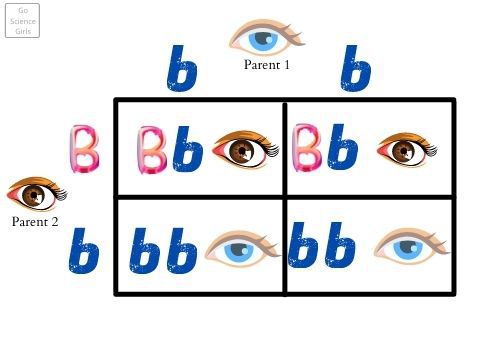
However, if one allele of the parent is brown, and the other is blue (heterozygous condition), there is still a chance for the eyes to be blue.
If genotypes of parents are homozygous blue and homozygous green, there is an equal probability of genes to express themselves. Understand through the diagram.
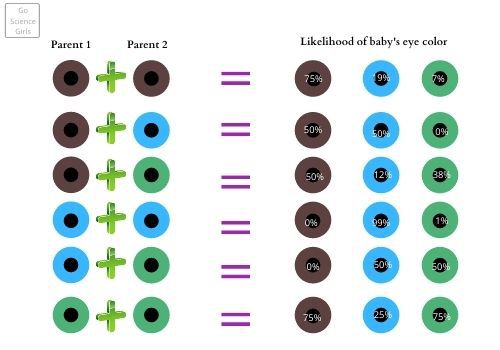
Genetically Inherited Baldness
There are dozens of contributing factors to baldness, but the two you need to pay attention to are genetics and male hormones.
If a person’s dad or brother is bald, they’re at a much higher risk for the same fate. And if they’ve experienced premature hair loss at an early age, they also may want to keep a close eye on your hormones. But how does genetic pattern-baldness take place?
Male-Pattern Baldness
Genetically inherited male pattern baldness is also known as androgenetic alopecia. These patterns mostly recur in families.
In men, it starts with hair thinning out over both temples, and eventually receding to an M-shaped hairline.
However, male-pattern baldness is generally associated with genes in the X-chromosome, that is, the one a boy inherits from his mother. The most important of these is the gene called 5-alpha-reductase (5AR).
This gene encodes a protein that converts testosterone to an androgen called dihydrotestosterone (DHT). If you inherit one or two copies of the faulty gene, the body will not make enough of the enzyme to convert testosterone into DHT.
Men with this form of baldness produce higher-than-normal amounts of DHT, and thus, may suffer from male-pattern baldness.
However, it’s not as straightforward as plain genetics from one side of the family. It’s a combination of faulty genes, hormone levels caused by stress, nutrition, and medication, and the natural ageing process.
It affects people differently, and the severity and stages of balding vary in each case. However, it is more likely for an offspring to have male-pattern baldness if a close relative suffers from it too.
Female-Pattern Baldness
There are many genes that may increase a woman’s risk of hair loss. Some women appear to be genetically programmed to lose their hair in adulthood, with others losing small amounts of hair gradually.
These genes are likely to be involved in regulating hormones and are linked to excess levels of male hormones called androgens, which cause increased levels of testosterone and an increase in the amount of testosterone converted into estrogen.
Similar to the case of male-pattern baldness, low levels of testosterone causes hair fall- large amounts of slow thinning at their hairline, a high receding scalp line, and probably some thinning on top of the scalp as well.
This is also generally associated with the X-chromosome, thus is from the mother to the daughter.
It’s not uncommon for a female hairline to recede during and after menopause. This is because women are genetically programmed to lose hair in a distinct pattern than men. Barely half of the population of women make it up to the age of 65 with a head full of hair.
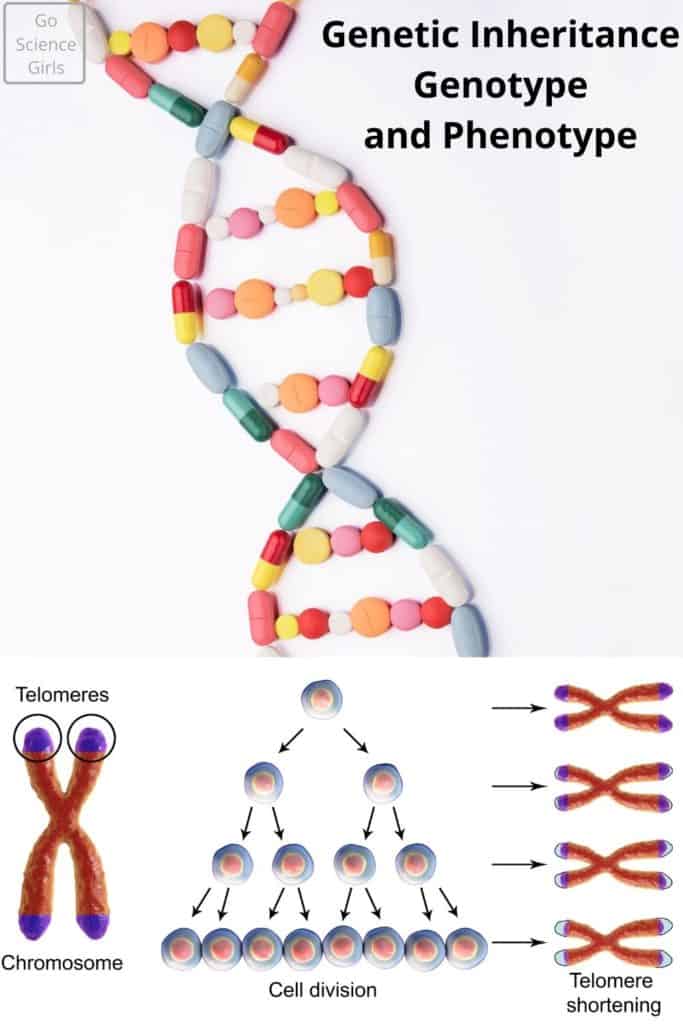
The Conclusion
Genetic inheritance is a big part of our everyday lives. Whether it be our eye color, skin complexion or personality traits, we inherit them from our parents.
This knowledge will help you analyze your own traits and those of your family.
Genetic inheritance also helps doctors diagnose certain handicaps and diseases in children. It’s an essential topic, which every one of us should be educated and be aware of.
